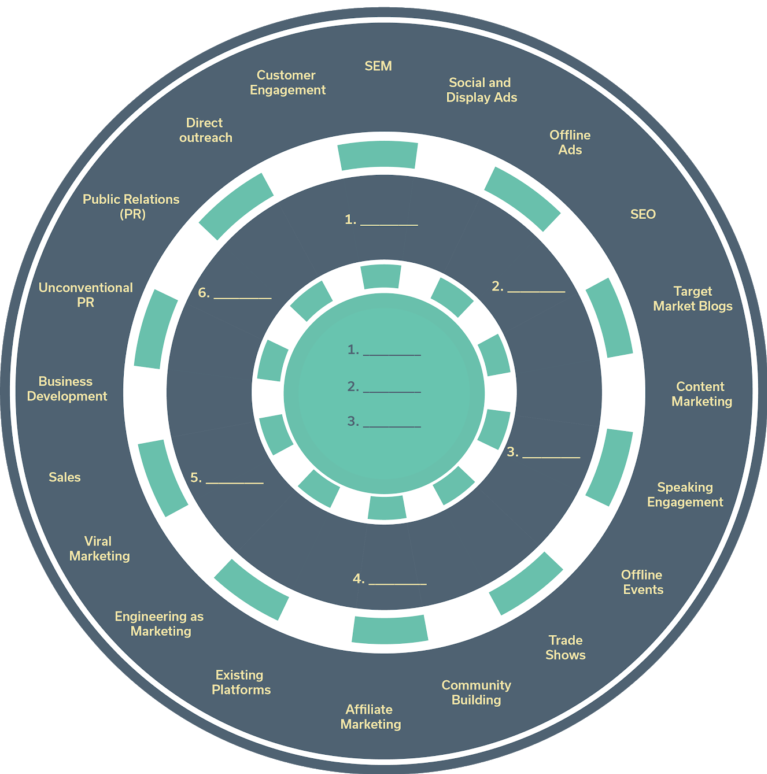The Bullseye Framework Explained

My role at Growth Division is to drive our own growth as a growth marketing agency. That means I’m always networking and talking with startup founders. These conversations are always fun, always inspiring, and always end up coming back to the same topic…. how to grow.
As a founder, or as part of a founding team, there is always this underlying desire to grow. And crucially, a desire to learn how to grow and how to build a growth marketing strategy. It’s one of the fundamental challenges and it’s never far from the minds of the founding team.
At Growth Division we see “strategy” not as a one-time document you do at the beginning of your startup journey, but an ever-evolving process of experimentation made up of specific hypotheses you’re trying to validate (or invalidate). One of the most important aspects to this is the specific traction channels you’re going to use, and how they’re going to interact with each other. Enter: The Bullseye Marketing Framework…
What is the Bullseye Marketing Framework?
The Bullseye Framework is a tool that allows you to hone in on the marketing channels that will yield success for your business in the long-term. In my opinion, it is the ultimate way to think about your growth marketing strategy as a startup founder. It was developed by the clever pair Gabriel Weinberg and Justin Mares.
The outer ring of the Bullseye represents all the possible growth or traction channels you can choose from to grow your business. In the original framework, there are 19 traction channels. At Growth Division we added a 20th channel (customer engagement) as we believed the theory could benefit from one small addition. Here’s a peek at our version of the Bullseye Marketing Framework:

The middle ring represents the process of whittling down the options to between 4 and 6 channels. These are the traction channels you believe have potential to move the needle for your company’s growth over the coming 6 months.
Finally, the centre circle is bullseye! In case you hadn’t guessed it, this is where you want to be. Once you’ve validated a channel as a scalable route to market it should become part of your long-term channel mix in the centre circle.
Step 1: Consider Your Target Audience
One thing we always bang on about at Growth Division is the importance of being customer-oriented. We’ve written more about this in our go-to-market-strategy article but before you start trying to create your middle ring of potential channels you need to understand your target audience.
That means… talk to them! Conduct interviews, run surveys, talk to your friends who fit your persona. You should gather data points (both qualitative and quantitative) and build a picture of your Ideal Customer Persona. This should include info about their demographics, geographics, pain points, goals and potential blockers. You should also think about where they hang out, where they gather information, where they do research before making a buying decision. All that learning will give you the tools you need to properly evaluate your traction channels….
Step 2: Review The Bullseye Framework Traction Channels
As this post is about explaining the Bullseye Marketing Framework I thought it would be useful to dive into each of the channels in turn. I’ll give a high-level overview of what the channel is and some standout examples of companies smashing each channel.
Remember, the point of the Bullseye Framework is not to tackle all 20 traction channels at once. It allows you to assess the marketing options available, make strategic choices, then validate using our recommend approach of hypotheses and growth experiments.
1. Search Engine Marketing (SEM)
SEM is paid advertising on search engines, whether it’s Google Ads, Bing Ads or other search engines. When people search for specific problems they are facing they have very high intent to purchase a solution. The channel works well if there are high search volumes for specific keywords and low competition on those works. It’s a highly measurable, predictable channel with a large focus on data-based decisions. That said, there’s also room for creativity when it comes to your advert copywriting.
Just like: Hubble Office Space – these guys own the paid searches for their brand.
2. Social & Display Ads
Social Ads are paid adverts on social media platforms. Display Ads are paid adverts on sites across the Google Display Network (GDN). Targeting on these platforms can be carefully refined to get in front of highly defined audiences, these can be extremely effective at top of the funnel awareness and conversions. GDN is most effective as an awareness play, or to re-market to people who have visited your site. Often social and display ads are paired with a lower-funnel SEM approach to build a full-funnel growth engine.
Just like: basically any competent ecommerce store will have highly targeted ads and re-targeting ads on GDN. Recently I got enticed into buying some Saye shoes due to some excellent social ads.
3. Offline Ads
Offline ads can range from advertising on public transport networks, to big billboard ads, to ads in magazines, to flyers, to handwritten letters. It can be a highly effective way to advertise if you have a big brand and want to raise awareness in a specific location or to specific demographics. Another use case might be physical businesses (like coffee shops) that want to advertise in a local area.
Just like: McDonald’s – when you’re in a 200-metre range of a McDonalds you’ll start to see ads for Big Macs on telephone boxes and signs. Then 200 metres later you notice McDonald’s and really feel like a Big Mac!
4. Search Engine Optimisation (SEO)
SEO, as the name suggests, is optimising your website to rank more highly on search engines and appear more frequently in searches containing specific words. As you can imagine, this can be quite a technical channel that needs a structured approach led by someone who knows what they’re talking about. The structure of the site, on-site content, number of backlinks, site speed, time on site and social signals are all variables in how search engines will rank your site. If you start ticking these boxes you’ll start to drive cheap, reliable, relevant organic traffic to your site. Growth Division had great success working with Clade on their site’s SEO. SEO is a channel that can take a bit of time to get going, but can pay off massively in the medium to long term.
Just like: MVF Global build high-traffic, optimised sites that rank highly on search engines to capture leads and send to partners who pay for leads. They built a large part of their business by ranking highly on search engines!
5. Target Market Blogs (TMB)
This involves getting mentioned on sites that have high volumes of relevant traffic on them, specifically by getting guest posts on them. This serves three important functions: firstly, it helps drive relevant traffic to your site secondly, it helps build the author’s (and subsequently the company’s) reputation as a thought-leader and finally, it drives up your domain authority through the backlink. It’s related to, and sometimes overlaps with, digital PR.
Just like: Kurve is one of our partners at Growth Division and the founder, Oren, has done a fantastic job at getting featured on well-known sites with high domain authority such as HubSpot, BuiltWith and Zapier. This has been a successful channel in helping the agency grow.
6. Content Marketing
Content marketing can refer to any number of forms of content from blogs, to videos to infographics. Content is a fantastic channel that can sit across the entire marketing funnel, helping drive awareness, educate prospects and improve conversions. It can also assist with your SEO and community building activities.
Just like: HubSpot is a great example of a business smashing its content marketing strategy. When searching for many startup or growth-orientated keywords you’ll find HubSpot on the first page.
7. Speaking Engagements
This channel is more of a B2B focused channel in the context of startups, it’s about getting members of the team to appear in events or shows as guest speakers. It can be huge for brand awareness and positioning your founding teams as thought leaders in your sector.
Just like: Daniel Priestley, in his book ‘Key Person of Influence’, advocates building the reputation of the founder as an industry leader by speaking. Priestley has been doing this himself to grow his various businesses.
8. Events
In the original Bullseye Marketing Framework, this was “offline events” but we’ve updated it in the context of a more digitally-focused world. This channel refers to creating your own branded events as a touchpoint in the sales/marketing process. Events can either be used as a top-of-funnel hook or a conversion tactic further down the funnel.
Just like: Salesforce Dreamforce is a superb example of this, albeit on a large scale. It’s an event that attracts 1000’s of Salesforce users and prospects from across the globe and is a crucial channel for the company to maintain it’s perception as a thought leader and as the industry-standard CRM.
9. Trade Shows
In B2B marketing trade shows can be a fantastic way to get in front of a highly relevant audience of potential buyers. You can benefit from brand exposure and if you have the right team at the show you can start some interesting conversations and hopefully generate plenty of leads.
Just like: Just Eat are at all the food-tech events and often will go all-out to sponsor the event or buy up large stands covered with their branding.
10. Community Building
Building a community around the problem your business is solving can be a very effective way of being the top-of-mind solution when people think about the problem when they experience it. A community can solidify your reputation as a go-to, trustworthy solution. Building a community can also be an effective way to validate a market before launching, then selling into the community when you launch, using the members as early adopters. We wrap organic social management into ‘community building’ at Growth Division – because a properly maintained organic social presence should feel like a community. Posting good quality content to your community across social channels can support paid ads or direct outreach very effectively.
Just like: LemList have a Facebook Group for people who use email outreach marketing as a channel to market where people share “hacks” and ideas to their fellow members, especially ones that revolve around the LemList tool.
11. Affiliate Marketing
Using affiliate partners can be a hugely scalable and effective way to grow sales as you’re enlisting other marketers to leverage their audience and/or growth skills to make more sales. In return, you give a commission on each sale the affiliate partner makes. For certain B2C companies it can be an incredibly effective way to scale quickly.
Just like: Pipedrive, and in fact many SaaS companies, have successfully leveraged affiliate partners to drive sign-ups. By partnering with CRM consultants, marketing agencies and other partners they have driven sign-ups.
12. Existing Platforms
This is a bit of an “out-there” channel for growth, the premise is to take advantage of other platforms’ traffic by redirecting it to your site. This could either be by leveraging audiences in Facebook or Slack groups or diverting traffic from other sites and platforms. It can be a bit underhand if not thought through carefully, so be careful when planning this growth marketing channel out.
Just like: A super famous example of this is Airbnb posting their listings on Craigslist. In their early days of growth, this tactic drove large volumes of traffic to their site and was imperative to their early growth.
13. Engineering as Marketing
This is a favourite channel for growth marketers, it’s building a tool to use as some form of “product for prospects”. You might see an opportunity to offer people a useful tool that enables you to capture their email address so you can market to them. This could come in the form of calculators, templated spreadsheets or makeshift tools (using tools like Outgrow). It can worth for B2B, for example by building free tools to capture leads, or B2C by building quizzes or giving away ‘free’ versions of the product.
Just like: My favourite example of this is HubSpot’s email signature creation tool. HubSpot wants to target businesses just setting up their CRM, and every new business owner wants a fancy new email signature. Low and behold, Hubspot’s tool ranks highly on Google searches for this.
14. Viral Marketing
Viral marketing, in the context of B2C, or referral marketing, in the context of B2B, can be a highly effective marketing channel to grow your business. By leveraging your existing customer base and their networks you can drive large amounts of relevant traffic. It’s one of the channels that, if done right, can lead to exponential growth.
Just like: When Monzo was launching they had a leaderboard system where you could jump the queue if you referred other people, this system enabled them to grow quickly and build up hype around their product.
15. Sales
This is a purely B2B marketing channel. Building a sales process and sales team to sell your product can be very effective, especially when it is fueled by a well-oiled lead generation engine. It is sales job to get on the phone and speak directly to customers.
Just like: Epos Now had a sales team that was responsible for a lot of the growth in the company successfully growing across the UK and beyond. Cold calling, demo’ing, boots-on-the-ground sales reps were key drivers in their growth.
16. Business Development
In the terminology used in the Bullseye Framework, Business Development is building partnerships with other businesses who are “fishing in the same (customer) pond” as you. Partnerships have the potential to be very scalable and cost-effective routes to market, as you have other people recommending your business. However, it isn’t as easy as it sounds to build a successful partnership, it takes time, effort and aligned incentives to make this channel work effectively.
Just like: Zapier is a great example of a company using technology integration partnerships as a way to attract new customers and serve the customer more effectively.
17. Unconventional PR
As you might guess from the name, this is about doing something a bit “out there” to get media coverage or attention. It’s not necessarily the most repeatable strategy but it is one that can get you huge amounts of attention.
Just like: Richard Branson driving a tank in Times Square, New York. Need I explain more?
18. Public Relations (PR)
This refers to more conventional PR, where your company tries to get media coverage at specific, targeted outlets. This could be both paid-for coverage or organic coverage. If you’re targeted in your PR outreach and manage to get exposure on a platform that your target audience reads this can have a massive impact.
Just like: The ALS Ice Bucket Challenge is a top example of using PR as a way to grow awareness of your brand/product. The videos of people pouring ice water over their heads went so viral media outlets reported on it.
19. Direct outreach
This is a B2B growth channel. It’s a highly effective one if you have a really targeted Customer Persona, as you can gather highly relevant data to reach out to. It’s one we have a huge amount of success with at Growth Division for B2B startups, especially when combined with social and display ads on LinkedIn and community building.
Just like: Growth Division successfully help startups run this channel, for example, Bippit is getting qualified meetings booked in their sales team’s diaries each week.
20. Customer Engagement
We added this 20th channel to the Bullseye Framework mix. This channel is focused further down the funnel. It’s about engaging existing customers to spend more, or remain as a customer for longer and ultimately improving the customer’s lifetime value (LTV). You can use email and notification mechanics to continually re-engage and upsell customers. We see improving LTV as a core part of the growth marketer skillset, as well as reducing customer acquisition costs.
Just like: Deliveroo is a good example of a company with a solid customer engagement strategy, encouraging users to repeatedly use the app through notifications, emails, offers and prompts.
Step 3: Track Your Customer Acquisition Cost (CAC)
Once you’ve got your middle ring, you want to get testing. But how do you know what’s working and what’s not?
A core part of measuring effectiveness of traction channels is to track customer acquisition cost – both as a whole, and for individual channels.
It will tell you how efficient any particular effort is at generating new customers for the business.
BUT. And it’s a big but. It’s so, so important you don’t get trapped into pitting channels against each other. The ideal traction channel mix should complement each other. Some channels will naturally show a good CAC – for example, SEM or direct outreach. But your data on that may not show the impact your blogs, community building or PR is having on the conversion rates from SEM and direct outreach. So it’s important to treat each channel on its own merits, and test them thoroughly, before you make decisions about what’s working and what’s not working.
So, when should I use the Bullseye Framework?
In short, the Bullseye Framework is a great tool to build out your initial growth marketing strategy. Importantly, it also conceptualises the process of continuous testing and proving your strategy over time as you move from the outer circle into the middle of the bullseye.
Your marketing strategy should not be a one-time process, but something that you’re continuously trying to validate. Likewise, the Bullseye process isn’t something to do once, but over time. Your channel mix will need to change and be reviewed at different stages of your company’s growth. We recommend re-doing the Bullseye every 6 months to keep your strategy fresh and up-to-date.
Get in touch for a free Bullseye workshop session

Built by founders, for founders
Growth Division’s founding partner Tristan wrote this article and is an expert in Go-To-Market planning for startups. He leads the Bullseye sessions with prospective founders. He will help you set objectives, plan your budget and then build a suitable channel mix.
Related Posts

What Is a Growth Marketing Manager?
Discover the ins and outs of the role of a Growth Marketing Manager.

Harness the Power of Growth Marketing for Business Success
Learn how to harness the power of growth marketing to propel your business to new heights of success.

How to Build Long-Term Sustainable Growth
Learn the essential strategies and practical steps to achieve long-term sustainable growth for your business.
